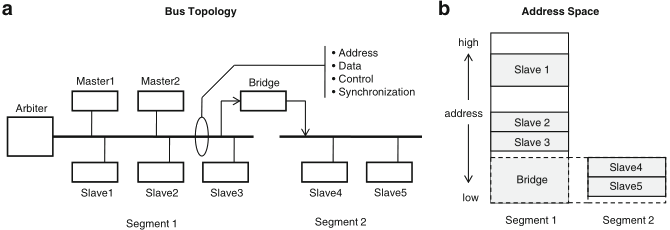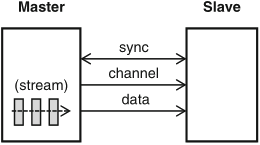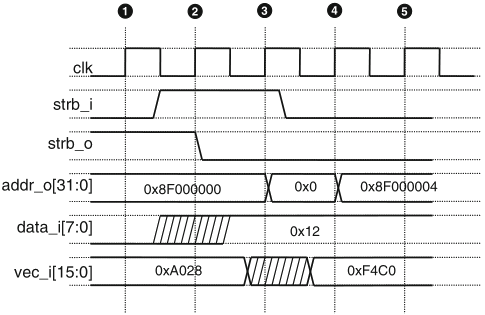DMI – Graduate Course in Computer Science
Copyleft
![]() 2016-2017 Giuseppe Scollo
2016-2017 Giuseppe Scollo
this tutorial deals with:
four families of on-chip bus standards, among the most widely used ones:
two main classes of bus configurations: shared and point-to-point
a generic shared bus and a point-to-point one are considered next, abstracting common features of all of them
| Bus |
High-performance shared bus |
Periferal shared bus |
Point-to-point bus |
| AMBA v3 | AHB | APB | |
| AMBA v4 | AXI4 | AXI4-lite | AXI4-stream |
| CoreConnect | PLB | OPB | |
| Wishbone | Crossbar topology | Shared topology | Point to point topology |
| Avalon | Avalon-MM | Avalon-MM | Avalon-ST |
|
AHB AMBA highspeed bus, APB AMBA peripheral bus,
AXI advanced extensible interface, PLB processor local bus, OPB onchip peripheral bus, MM memory-mapped, ST streaming | |||
Schaumont, Table 10.1 - Bus configurations for existing bus standards
a shared bus on-chip typically consists of a few segments, connected by bridges; every transaction is initiated by a bus master, to which a slave responds; if they are on different segments, then the bridge acts as a slave on one side and as a master on the other side, while performing address translation
four classes of bus signals:

Schaumont, Figure 10.1
- (a) Example of a multi-master segmented bus system.
(b) Address space for the same bus

Schaumont, Figure 10.2 - Point-to-point bus
a point-to-point bus is a dedicated physical connection between a master and a slave, for unlimited stream data transfer
figure 10.3 shows the physical layout of a typical on-chip bus segment with two masters and two slaves, where AND and OR gates in the center of the diagram serve as multiplexers, of both address and data lines

Schaumont, Figure 10.3 - Physical interconnection of a bus. The *_addr, *_wdata, *_sdata signals are signal vectors. The *_enable, *_grant, *_request signals are single-bit signals
signal naming convention about read/write data:
bus arbitration ensures that only one component may drive any given bus line at any time
naming conventions help one to infer the functionality and connectivity of wires based on their names
a component pin name will reflect the functionality of that pin; bus signals, which are created by interconnecting component pins, follow a convention, too, in order to avoid confusion between similar signals
in some bus systems, the instance names of both master and slave will be included as part of the bus signal name
adoption of the naming conventions of the particular bus in use avoids coding mistakes and connection errors, it makes code reusable, and it simplifies debugging and verification
because of the inherently parallel nature of a bus system, timing diagrams are extensively used to describe the timing relationships of bus signals

Schaumont, Figure 10.4 - Bus timing diagram notation
the diagram in figure 10.4 shows the notation to describe the activities in a generic bus over five clock cycles
bus timing diagrams are very useful to describe the activities on a bus as a function of time
table 10.2 lists the signals that make up a generic bus, abstracting from any specific bus system
| Signal name | Meaning |
| clk | Clock signal. All other bus signals are references to the upgoing clock edge | m_addr | Master address bus | m_data | Data bus from master to slave (write operation) | s_data | Data bus from slave to master (read operation) | m_rnw | Read-not-Write. Control line to distinguish read from write operations | m_sel | Master select signal, indicates that this master takes control of the bus | s_ack | Slave acknowledge signal, indicates transfer completion | m_addr_valid | Used in place of m_sel in split-transfers | s_addr_ack | Used for the address in place of s_ack in split-transfers | s_wr_ack | Used for the write-data in place of s_ack in split-transfers | s_rd_ack | Used for the read-data in place of s_ack in split-transfers | m_burst | Indicates the burst type of the current transfer | m_lock | Indicates that the bus is locked for the current transfer | m_req | Requests bus access to the bus arbiter | m_grant | Indicates bus access is granted |
Schaumont, Table 10.2 - Signals on the generic bus
table 10.3 shows the correspondence of some of the generic bus signals to equivalent signals of the CoreConnect/OPB, AMBA/APB, Avalon-MM, and Wishbone busses
| generic | CoreConnect/OPB | AMBA/APB | Avalon-MM | Wishbone |
| clk | OPB_CLK | PCLK | clk | CLK_I (master/slave) |
| m_addr | Mn_ABUS | PADDR | Mn_address | ADDR_O (master) |
| ADDR_I (slave) | ||||
| m_rnw | Mn_RNW | PWRITE | Mn_write_n | WE_O (master) |
| m_sel | Mn_Select | PSEL | STB_O (master) | |
| m_data | OPB_DBUS | PWDATA | Mn_writedata | DAT_O (master) |
| DAT_I (slave) | ||||
| s_data | OPB_DBUS | PRDATA | Mb_readdata | DAT_I (master) |
| DAT_O (slave) | ||||
| s_ack | Sl_XferAck | PREADY | Sl_waitrequest | ACK_O (slave) |
Schaumont, Table 10.3 - Bus signals for simple read/write on Coreconnect/OPB, ARM/APB, Avalon-MM and Wishbone busses
the two tutorials on the Qsys tool, available in Quartus, that are indicated in the references, respectively show how to:
it is proposed to replicate the execution of these two experiments and to expose, in the lab experience report, the encountered difficulties together with solutions adopted to overcome them
recommended readings:
readings for further consultation:
useful materials for the proposed lab experience: